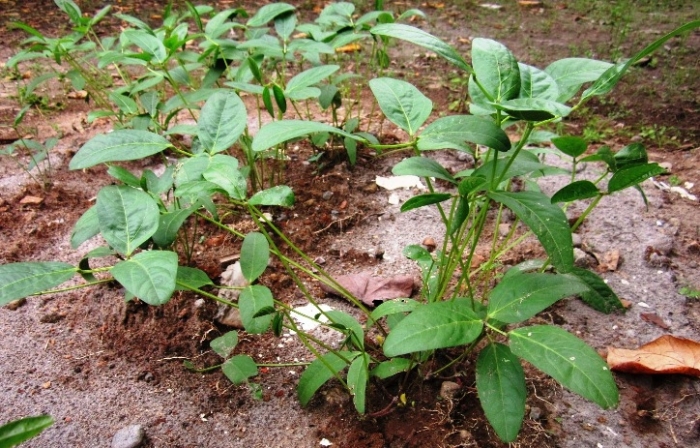Bambarra Groundnut
(Vigna subterranea)
Bambarra Groundnut (Vigna subterranea)
/
/

Kembangraps
CC BY-SA 3.0
Image By:
Kembangraps
Recorded By:
Copyright:
CC BY-SA 3.0
Copyright Notice:
Photo by: Kembangraps | License Type: CC BY-SA 3.0 | License URL: https://creativecommons.org/licenses/by-sa/3.0/de/deed.en | Uploader: Kembangraps | Publisher: Wikimedia Commons |








Estimated Native Range
Summary
Vigna subterranea, commonly known as Bambarra Groundnut, is an annual herb that is native to West Africa, particularly thriving in savannahs and open grasslands. It is a significant crop in semi-arid regions of Africa due to its drought tolerance and nutritional value. The plant typically grows to a height of 30-70 cm with a growth cycle ranging from 90 to 170 days, depending on environmental conditions. The flowers of the Bambarra Groundnut are small and yellow, appearing 40-60 days after planting. The pods, which contain the edible seeds, mature underground similar to peanuts, approximately 30 days after pollination, with the seeds fully developing after another 55 days.
The Bambarra Groundnut is valued for its resilience to drought and its ability to grow in poor soil conditions, making it a staple crop in challenging environments. It is also appreciated for its nutritional seeds, which are high in protein and can be consumed fresh, boiled, or ground into flour for various dishes. In cultivation, it requires full sun and does well with medium water availability. The optimal soil for Bambarra Groundnut production is sandy to prevent waterlogging, with a depth of 50-100 cm and a light texture. Soil fertility should be low, and the pH should range between 5 and 6.5. While the plant is drought-resistant, it is susceptible to root rot in waterlogged conditions and may suffer from pests such as aphids and weevils.CC BY-SA 4.0
The Bambarra Groundnut is valued for its resilience to drought and its ability to grow in poor soil conditions, making it a staple crop in challenging environments. It is also appreciated for its nutritional seeds, which are high in protein and can be consumed fresh, boiled, or ground into flour for various dishes. In cultivation, it requires full sun and does well with medium water availability. The optimal soil for Bambarra Groundnut production is sandy to prevent waterlogging, with a depth of 50-100 cm and a light texture. Soil fertility should be low, and the pH should range between 5 and 6.5. While the plant is drought-resistant, it is susceptible to root rot in waterlogged conditions and may suffer from pests such as aphids and weevils.CC BY-SA 4.0
Plant Description
- Plant Type: Herb
- Height: 0.5-1 feet
- Width: 0.5-1 feet
- Growth Rate: Moderate
- Flower Color: N/A
- Flowering Season: Summer
- Leaf Retention:
Growth Requirements
- Sun: Full Sun
- Water: Medium
- Drainage: Medium, Fast
Common Uses
Bird Garden, Butterfly Garden, Edible*Disclaimer: Easyscape's listed plant edibility is for informational use. Always verify the safety and proper identification of any plant before consumption., Low Maintenance
Natural Habitat
Native to West African savannahs and open grasslands
Other Names
Common Names: Ground-Bean, Bambara Nut, Congo Goober, Earth Pea, Bambara Groundnut, Bambara-Bean, Congo Goober, Hog-Peanut, Bambaraerdnuß, Bambarra
Scientific Names: , Vigna subterranea, Voandzeia subterranea, Vigna subterranea var. spontanea, Glycine subterranea, Arachidna trifolia, Cryptolobus africanus, Cryptolobus subterraneus, Geolobus flavus, Tetrodea subterranea
GBIF Accepted Name: Vigna subterranea (L.) Verdc.